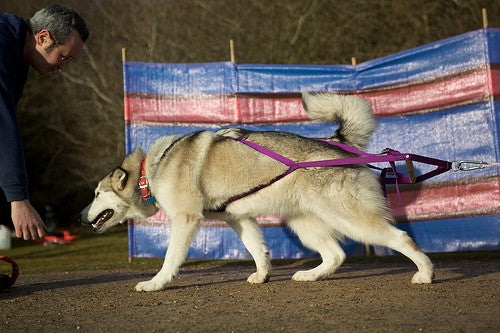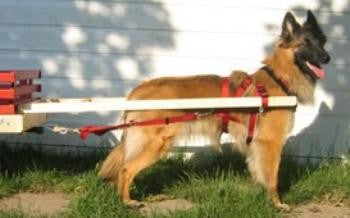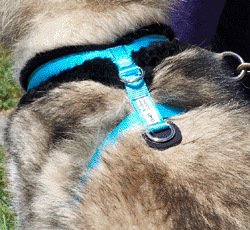Since we began our journey with sled dogs over ten years ago - I have spent a lot of time trialing walking harnesses and working out which are up to the somewhat colossal job of working with big, strong pulling dogs (in our case, Alaskan Malamutes) daily. From early on we decided to walk our dogs almost exclusively in harnesses. This is a personal choice - and each owner will have a different idea about what works best for them, but this is how we love to walk our dogs.
First and foremost, we chose not to use harnesses that restrict the dog’s ability to pull in any way - as they are sled dogs, and pulling is their job. In fact, training the dogs to walk in harness without pulling us became just another job for them, something to keep them mentally stimulated on even short walks. And though we have four very different dogs from different lines, all of them took to it beautifully and have lovely harness walking manners. When we first began some competitive dog owners voiced concerns to us that training ‘non-pulling’ manners may discourage their running well in harness, and so I do know a lot of racing sled dog owners who won’t use this method for dog walking, and it is always good to speak to many people and get different perspectives before making this decision.

After multiple dogs and ten plus years, I’ve had a very different experience, and wanted to take a minute to share that so that anyone beginning their journey with competitive harness racing dogs will have both sides to consider when making decisions about how you want to go about walking your dogs. I will be discussing Malamutes specifically - but I believe the principles are the same across breeds when breed specific training and intuition are utilised.
A great many very experienced and highly competitive mushers walk their dogs either primarily or entirely on the collar. There will be too many varied reasons for this for me to make any generalities here, but a few big ones that I know of are the strength of the pull that they have makes it much easier to manage them on the collar when they simply can’t pull as hard as they are able in a harness. This is a really valid concern and it is most certainly true that more direct control can be obtained by a collar. This is often further extended by the use of a Canny Collar for situations where added control is needed. The second really valid reason is that to discourage pulling in harness which you have to do unless you want to be dragged endlessly on every walk, may lead to them being less likely to pull when it comes time to work.

We considered both of these things carefully when we started out - and as with everything in our time with Malamutes - we are so thankful we had our wild and headstrong girl, Memphis, to begin with - because she made us work hard to learn everything we needed to know. What we discovered very early on with Memphis was that she was much calmer on the harness. Still profoundly excited, still pulled like a train - but the frenetic energy (of which she had lots in her early years) was calmed when she was in harness. Also - we noted - she listened better. It may have been harder to hold her initially when beginning harness training, but it was so much easier to get her to attend us and to focus doing the work. Once the collar went tight - all she wanted to do was move away from it.
We persevered with the harness training until she walked really nicely and made the resigned decision that if it was detrimental to her working ability - so be it. It was better to have a dog that was happy and relaxed on the multiple walks we took every day than to be winning races.
However - what we soon realised, was that the reason Memphis was so much calmer and easier to train was that in a harness - she naturally felt like she was working. And working with malamutes is so much more than simply pulling. It’s teamwork, it’s listening to each other, it’s signaling back and forth all the little things you want to convey to each other - be it a walk, or a race - or a 20 mile trek. Every walk became a training exercise - and every day she got a little better.
The second thing we noted (and we take no credit whatsoever for this - I believe this is just down to good dogs bred for purpose) for them, there was no mistaking the difference between a walking harness and a running harness. The pull point on a good walking harness like the Front Range discussed below is much higher, between the shoulder blades. The pull point on an X-back racing harness follows the whole length of the body with a focus on the chest and shoulders. The moment Memphis first went into an X-back her whole body aligned to it, and she turned into a pulling machine.

We never - for a moment- had any confusion between the two. Excited encouragement to pull a few times in an X-back harness before her first runs, and she took to running on a rig with zero hesitation. Furthermore - her walk the next morning in her Front Range harness was as calm and well-mannered as ever. I strongly believe the dogs are completely capable of making this distinction between harnesses and their intended purpose, and though any dog is going to require careful harness training (and sled dogs may need more), if you are happier walking your dogs in harness then I can say with confidence it is completely possible without hindering their harness work.
Memphis went on to be one of the most competitive malamute bitches in the UK of the past decade, winning the top racing awards, and though all four of our malamutes are completely different dogs, with different temperaments, work ethics and running styles - all of them walk beautifully in harness and all of them are competitive runners.
For full disclaimer - we do still use the collar walking for high-intensity situations when we want optimum control (such as going into the vets, walking into shows or arriving at races, or where there may be loose dogs). We’ve never moved to head collars, however, and I feel that’s because our dogs find the added control of collar walking so different that they don’t pull against it as much as a dog who is perhaps more used to the sensation of pulling against a collar.
So - we had made the decision to harness walk dogs who weigh into the 40 kilo range and can pull over 1000 lbs. What harnesses are suitable for such a dog?
We narrowed ours down to several favourites - but our all around go-to harness that every one of our dogs begins with, is the Ruffwear Front Range. Some of our larger, stronger dogs have upgraded to a second harness when they reach their prime fitness (which I will review in future) but all of them start on the Front Range and have worn it at different points in their life for different reasons.
My first favourite thing about the Front Range is the fit. This is a beautifully fitting harness. It lays flat on the dog’s coat and so doesn’t rub anywhere, and molds to the dogs build. We’ve never once had any sores or rubbing issues from any one of these harnesses, no matter how many miles we’ve been out, or how much coat the dog has. The flatness of the harness also means it covers a larger surface area of the dog’s shoulders so that the pull is somewhat dispersed across the harness and isn’t focused on one point that may pinch or rub. This is especially important in two instances - one is in young dogs learning to walk in harness (you don’t want them discouraged, distracted or uncomfortable or training becomes infinitely harder) and the second is with a dog who’s had an injury. When our largest boy Sawyer injured his back, I put him back into a Front Range harness again because it was gentler across his back, neck and shoulders than the other harness he wore which sometimes focused the tension too much where his pain was.

This harness never rucks up when pulled from below, the front or the side as some harnesses can. This is particularly useful in hill walking, as you may be below or in front of the dog on an incline.
The second and my very favourite element of the fit is the flexibility. I have started every Malamute I have had with a Front Range around 6 months. I always buy a size L/XL which most Malamute puppies can fit into at that age. My malamute’s range in size and shape quite a lot - my smallest is 30 kilos and 23 inches at the shoulder, my biggest is 42 kilos and 26 inches at the shoulder. They have different chest sizes, different body lengths, different coat thickness (both in and out of coat) and every one of my dogs can wear the L/XL. I keep extra Front Ranges in the van on the off chance I leave and forget a harness - because any one of the dogs can wear it if necessary.
This is actually a huge thing with a growing team of different sized dogs.
Durability. This is a must for any sled dog harness. Not just because you want it to last, but because you absolutely must trust it to hold up in those moments where something gets the best of them (or they are learning) and they really, really pull. I love the clips on these harnesses - very robust, as is the lead attach point. I’ve never in ten years had a clip snap. Also because of the way these harnesses fit, it’s easy to get a really snug fit on the dog without them being tight, which means there is very little chance of the harness slipping over the head - even on the wriggliest dog (again - thank you Memphis for teaching us that lesson!) I’m very happy with the strength and durability of these harnesses though some harnesses I have used have lasted a bit longer. With Front Range I tend to replace after a few years of use. I generally would expect to get at least three years out of them before I replace just to be on the safe side but some of them, I have had upwards of 5 or 6 years which is a lot of miles considering how much we walk our dogs.
And as a final point - colours. A minor point perhaps - but I love the range of colour options they have as it’s great to be able to see at a glance exactly which harness belongs to which dog, even if they’ve been tossed in a pile after a big trip. They clean easily - and look great for years.
If you were unsure about whether to harness walk your big, pulling dog - I can say that it definitely can be done and without restricting their chest and movement in any way. It takes time and patience, and a really good harness, but for us, was well worth the effort.







































































